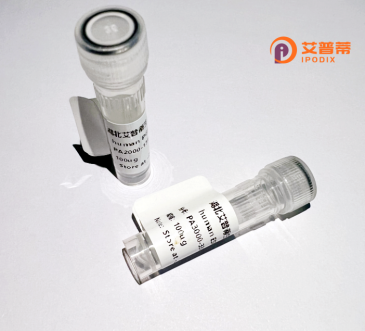
| 纯度 | >90%SDS-PAGE. |
| 种属 | Human |
| 靶点 | HBLD1 |
| Uniprot No | Q86U28 |
| 内毒素 | < 0.01EU/μg |
| 表达宿主 | E.coli |
| 表达区间 | 1-154aa |
| 氨基酸序列 | MAAAWGSSLTAATQRAVTPWPRGRLLTASLGPQARREASSSSPEAGEGQICLTDSCVQRLLEITEGSEFLRLQVEGGGCSGFQYKFSLDTVINPDDRVFEQGGARVVVDSDSLAFVKGAQVDFSQELIRSSFQVLNNPQAQQGCSCGSSFSIKL |
| 分子量 | 42.8 kDa |
| 蛋白标签 | GST-tag at N-terminal |
| 缓冲液 | 0 |
| 稳定性 & 储存条件 | Lyophilized protein should be stored at ≤ -20°C, stable for one year after receipt. Reconstituted protein solution can be stored at 2-8°C for 2-7 days. Aliquots of reconstituted samples are stable at ≤ -20°C for 3 months. |
| 复溶 | Always centrifuge tubes before opening.Do not mix by vortex or pipetting. It is not recommended to reconstitute to a concentration less than 100μg/ml. Dissolve the lyophilized protein in distilled water. Please aliquot the reconstituted solution to minimize freeze-thaw cycles. |
经检索,"HBLD1"可能为名称拼写或简称误差,暂时未查到直接相关文献。若您指的是人β-防御素1(HBD-1),以下为相关重组蛋白研究的文献概要:
---
1. **名称**: *"Antimicrobial activity of human beta-defensin 1 production in yeast"*
**作者**: Hiratsuka T. et al. (2003)
**摘要**: 研究利用毕赤酵母系统重组表达HBD-1蛋白,证实其具有广谱抗菌活性,对抗大肠杆菌和白色念珠菌效果显著。
2. **名称**: *"Expression and characterization of recombinant human beta-defensin-1 in E. coli"*
**作者**: Zhang L. et al. (2005)
**摘要**: 通过大肠杆菌表达系统优化HBD-1的可溶性表达,纯化后验证其抗菌功能及热稳定性,为大规模生产提供方法。
3. **名称**: *"Structural determinants of human HBD-1 activity in tumor microenvironment regulation"*
**作者**: Drogemuller K. et al. (2008)
**摘要**: 分析重组HBD-1的蛋白结构,发现其通过CCR6受体调控免疫细胞趋化性,可能在癌症免疫治疗中起作用。
---
**建议**:若目标蛋白名称有误或涉及新型蛋白,请进一步确认拼写(如HBD-1、HBLD家族其他成员),以便提供更精准的文献信息。
Here’s a concise description of recombinant human HBLD1 protein:
Recombinant human HBLD1 (HβD-1. Human Beta-Defensin 1) is a small cationic host-defense peptide belonging to the defensin family. Naturally expressed in epithelial tissues (skin, respiratory tract, urogenital tract), it plays crucial roles in innate immunity through broad-spectrum antimicrobial activity against bacteria, fungi, and viruses. Structurally characterized by a conserved β-defensin fold with six cysteine residues forming three disulfide bonds, its amphipathic structure enables membrane disruption of pathogens.
The recombinant form is typically produced via bacterial (E. coli) or mammalian expression systems to overcome low natural expression levels and enable scalable production. Purification challenges stem from its cysteine-rich nature requiring proper disulfide bond formation. Current research focuses on its dual functions: direct microbicidal action and immunomodulatory effects (chemotaxis for immune cells, cytokine induction). Potential therapeutic applications include combating antibiotic-resistant infections, adjunct cancer therapies, and chronic inflammatory skin disorders. Recent studies also explore its role in maintaining microbiota homeostasis and epithelial barrier integrity. As a research tool, recombinant HBLD1 aids mechanistic studies of defensin biology and host-pathogen interactions. Clinical translation efforts address stability optimization and delivery methods.
×